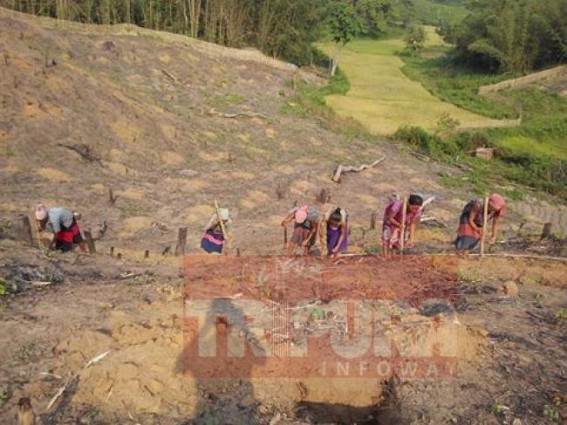TIWN

AGARTALA, May 12 (TIWN): Jhum or shifting cultivation is the dominant land-use practice of North-Eastern state Tripura. It is an ecological and economically viable system of agriculture as long as population densities are low and Jhum cycles are long.
The population explosion and increased demand for cultivable land have resulted in reduction of Jhum cultivation cycle.
This is seriously affecting livelihoods and environmental security in the region. Keeping this in view, the present study was conducted to find the livelihood status of tribal people practicing Jhum in Tripura.
The study revealed Tripura state in North- East india tribal farmers using structured interview schedule.
The study has revealed that the livelihood status of the majority farmers was low. The area under Jhum and the number of family members involved in Jhum have been found to contribute highest to the variations in livelihood status of tribal people in this region.
Jhum cultivation or slash-and-burn agricultural system, also known as shifting cultivation is an age-old agricultural practice by the ethnic tribal communities of uplands and it is still prevalent in all the northeastern states. The existing practice of jhum cultivation in Tripura as one of the anthropogenic and unscientific form of land use which is influencing the biodiversity to impede the ecological balance of the region. Over the last few years emergence of a new class of shifting cultivators who reduced the earlier 15–20 year cycle of shifting cultivation on a particular land to 2–3 years now resulted in large-scale deforestation, soil and nutrient loss, and by the way affecting the indigenous biodiversity to a large extent.
For shifting cultivation farmers generally select a forest patch and clear fell the vegetation normally in December and January. Thereafter, they burn the vegetation. During this practice, small, cut-trunks portion and roots are normally not removed. The herbs, shrubs and twigs and branches (slashed vegetation) are burnt in February and March. Sowing of seeds is followed during April and May. They will continue the cultivation for a few years and abandon the cultivated site and shift to other forest sites. After that they will return to the former site, and once again practice shifting cultivation on it. From the erosion point of view, the second year of jhumming cycle is more hazardous than the first year
It was noted that loss in forest was mainly due to the shifting cultivation. Degradation of forest causes ecological imbalance, rapid drying up of small water sources, and loss of productivity of land causing reduction in family income and enhancement of poverty in absence of any subsidiary income.
Although jhuming has many benefits from livelihood point of view, but in long run it destroys the ecosystem balance because one inch soil formation in nature takes about 1000 years. But several inches of soil are washed out each year due to jhuming.
- 'Intolerable.....' Corporators Lodged FIR against Madhabi Biswas over 'Insane Video' on social media targeting PM & Mayor
- Blood Donation Camp Organized in Sipahijala District
- Yuvrajnagar Panchayat Samiti Chairperson's Husband Denies Molestation Allegations
- CPIM Submits Memorandum for Fair Voter List Revision
- 23 Panchayats in Gauranagar Block Receive Computers, Printers, and LED TVs



